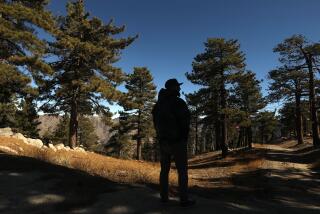Learning Outside In : The California Ski Center in Anaheim allows beginners to practice on indoor slope without getting cold or wet. The more advanced can hone skills too.
In balmy Orange County, fake snow is a lot more common than the real stuff. Around this time of year, for one thing, it helps the natives get into the holiday spirit.
Still, thereâs something incongruous about skiers shoosh -ing down a plastic slope in Anaheim, not far from the âsnowâ-covered slopes of Disneylandâs Matterhorn.
The California Ski Center on Harbor Boulevard houses not only a ski shop but a 100-feet bunny slope (complete with rope tow), carpeted in a bristly white plastic that simulates the conditions of real snow well enough to allow beginning and more advanced skiers to learn and practice their turns: wedge, wedge Christy, open parallel, wide track parallel and dynamic parallel.
Nearby, thereâs a gadget called the revolving slope. Sort of a treadmill for skiers, itâs a wide conveyor belt of carpet set on an incline and moving at a steady 8 m.p.h. Experienced users glide back and forth across the slope in a mesmerizing rhythm without moving backward or forward.
Classes taught on the stationary slope range from an âAâ level beginners class that covers side stepping, wedge turns, stops and how to get up after a fall, to a âCâ level class that polishes techniques learned in earlier lessons in addition to introducing more advanced turns. More advanced classes, labeled âDâ through âF,â are offered on the revolving slope.
On a recent Saturday, a class of 10 children ranging in age from 6 to 12 was on the slope for a combined âBâ and âCâ class. The plastic snow simulates a hard-packed powder, only slower, and allowed the kids to work on their technique without fear of a major spill. There were falls, but they were mostly of a slow motion, oops-I-crossed-my-skis variety.
Jim Garcia was one of two instructors working with the kids. After the class, he explained that beginners fall often, which is one reason that some people prefer to take their first lessons where itâs warm and dry. After a couple of indoor lessons, he said, beginners who then head to the mountains âdo fine. They can get down the mountain looking pretty good.â
âWhen theyâre first starting out, people are worried about getting wet and getting cold,â said manager Terry Jarmon. Also, first-time skiers can be intimidated just by the prospect of being out on the mountain. âWhen you look at our little hill, itâs nothing,â he said.
Most beginners who opt for the indoor lessons are people with an interest in skiing who just âwant to know if they can do it,â Jarmon said. âBefore they get on snow, they know how the equipment works.â
More experienced skiers often take refresher lessons in October and November as a way of warming up for the start of ski season, Garcia said. Also, he said, practice sessions are popular; many people come in on lunch breaks to ski for a half-hour and keep their technique honed.
The revolving slope is particularly good for refining technique, Jarmon said. It requires âmore precise skillsâ than real snow for a couple of reasons. The fairly narrow width (compared with a real ski slope) of the carpet and its texture require a well-carved turn. Also, he said, many skiers turn faster in one direction than the other; the constant speed of the revolving slope forces them to adjust.
Jarmon skied for 13 years before he tried the revolving slope. âIt brought out things I did not knowâ and helped iron out problems in his technique, he said. âItâs a great tool for working on habits.â
Being able to practice or learn skiing close to home is one of the selling points of California Ski Center.
Thereâs the cost factor as well. Lift tickets on area slopes cost as much as $38 per day, plus equipment rentals and the time it takes to get to the mountain. A 1 1/2-hour lesson at California Ski Center costs $35, including equipment rental, with package discounts available. Practice sessions on the stationary slope are $5 per half-hour; itâs $7.50 for a solo half-hour on the revolving slope.
Although the revolving slope and stationary slope are good for working on turns, they donât help when it comes to negotiating moguls. However, a small jump is added to the stationary slope for twice-weekly classes in the hottest new winter sport, snow boarding.
More akin in some ways to surfers or skateboarders than skiers, snow boarders ride down the slopes on a single board something like a skateboard, only larger. Some of the local resorts have routes particularly for snow boarders, including half-pipes that allow them to carom swiftly from side to side.
California Ski Center opened in 1976 and added its revolving slope two years later. There were once six or seven similar facilities in Southern California, but this is the last of its kind; Jarmon said the others were forced out by slow business or by the rising cost of liability insurance. California Ski Center reports solid business, with weekend lessons particularly well-booked during the season.
Business typically drops during the summer, picking up again in October, so the center has moved another traditionally outdoor sport indoors. As a way to attract customers to the store year-round, the center added an indoor rock climbing wall three years ago and offers lessons there as well.
The fake rock rises straight up from the fake snow. Whatâs next, indoor kayaking?
California Ski Center is at 1011 N. Harbor Blvd. in Anaheim. Information: (714) 776-7669.


